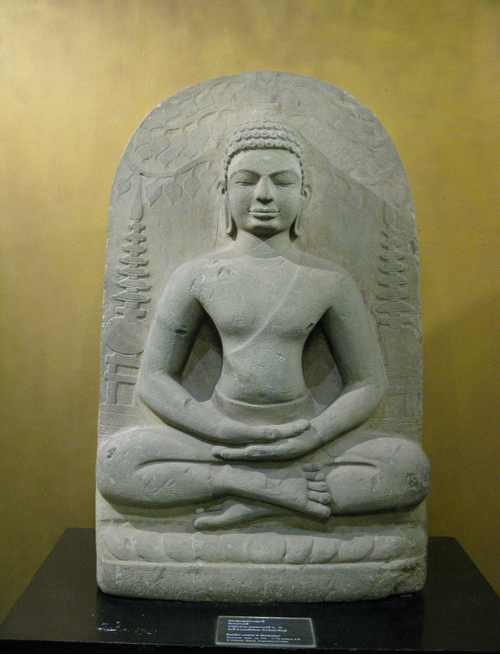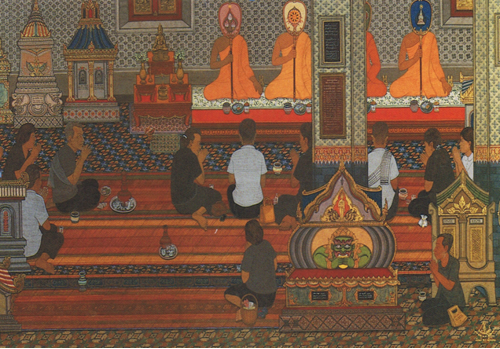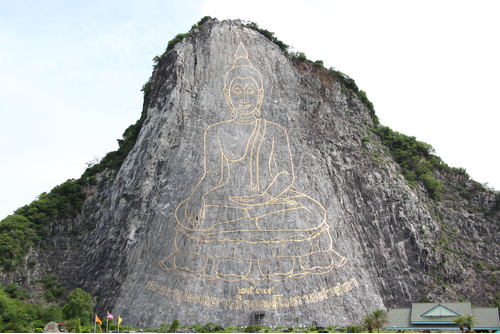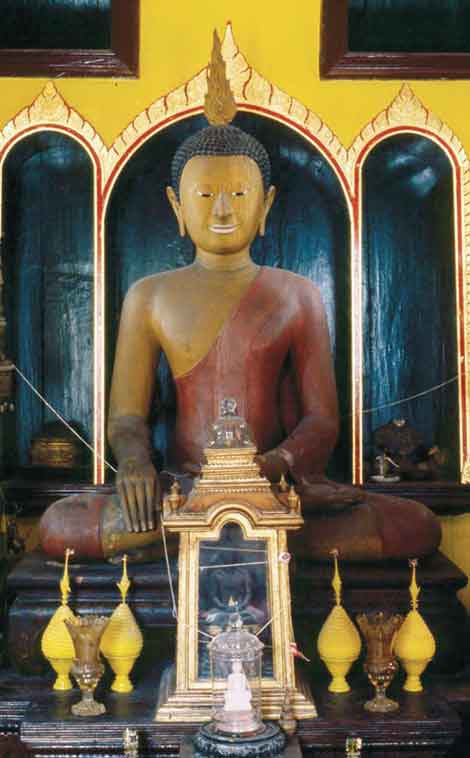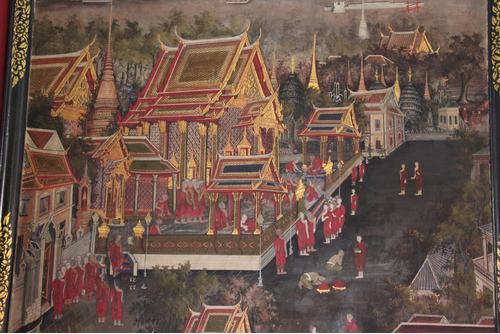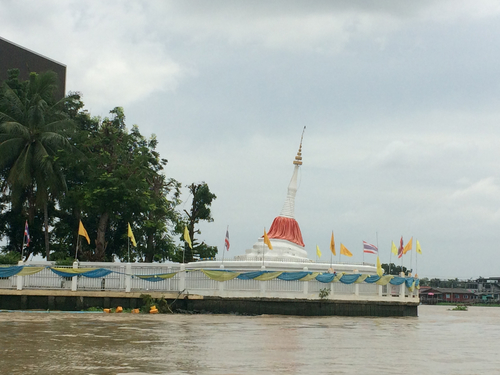ค้นหางานศิลปกรรม
ฐานข้อมูลศิลปกรรมในเอเชียตะวันออกเฉียงใต้
ประติมากรรมพระพุทธรูปปางสมาธิ
พระพุทธรูปอยู่ในอิริยาบถนั่งขัดสมาธิราบแบบแปลกๆ พระหัตถ์ทำปางสมาธิ ใช้ประดับศาสนสถานดังนั้นด้านหลังจึงตัดเรียบพระพักตร์เหลี่ยม พระขนงต่อกันเป็นปีกกา พระเนตรเหลือบต่ำแสดงความสงบ พระนาสิกใหญ่ พระโอษฐ์แบะ ขมวดพระเกศาเวียนเป็นวงก้นหอย พระอุษณีษะนูนสูงเด่น ยอดสุดเป็นพระรัศมีแบบลูกแก้วพระพุทธรูปครองจีวรห่มเฉียง ไม่มีริ้ว บางแนบพระวรกาย แลเห็นขอบสบงบริเวณบั้นพระองค์ชัดเจน ชายจีวรหรือชายสังฆาฏิซ้อนทบกันพาดผ่านเหนือพระอังสาซ้ายพระหัตถ์ทำปางสมาธิ พระเพลาสลักให้เห็นเป็นมุมมองจากด้านบนจนแลดูคล้ายกำลังนั่งแบบตั้งพระชานุ ถือเป็นมุมมองที่แปลก มีชายจีวรพาดผ่านตรงกลางผิดทับข้อพระบาท เมื่อมองจากทางด้านข้างจะพบว่าพระเพลาอยู่ในแนวเดียวกันกับพระอุระและพระอุทร ไม่ได้ยื่นพ้นออกมาทางด้านหน้า ทำให้พระเพลามีกายวิภาคผิดไปจากความเป็นจริง
ประติมากรรมพระพุทธรูปนาคปรก
พระพุทธรูปองค์นี้เป็นประติมากรรมนูนสูงปางนาคปรก พระพุทธองค์นั่งขัดสมาธิราบแบบหลวม พระหัตถ์ทำปางสมาธิ มีเพียงฐานหน้ากระดานเรียบๆรองรับพระพุทธองค์ไม่ใช่ขนดนาค พระพุทธรูปครองจีวรห่มเฉียง เรียบ บางแนบเนื้อ มีแนวชายจีวรพาดผ่านพระอังสาซ้ายยาวต่อเนื่องจนถึงข้อพระกรซ้าย แผ่นเบื้องหลังสลักนาค 7 เศียรปกอยู่เหนือพระเศียรของพระพุทธเจ้า ใบหน้าละม้ายคล้ายลิงอันเป็นลักษณะเด่นของนาคแบบทวารวดี สองข้างของพระพุทธรูปสลักรูปเจดีย์ทรงกลมข้างละ 1 องค์
ประติมากรรมพระพุทธรูปปางสมาธิ
พระพุทธรูปอยู่ในอิริยาบถนั่งขัดสมาธิราบแบบหลวมบฯฐานบัว พระหัตถ์ทำปางสมาธิ ด้านหลังมีแผ่นหลังทรงโค้งรองรับไว้เค้าพระพักตร์แตกต่างไปจากพระพุทธรูปที่พบจากภาคกลางทั่วไป พระพักตร์เหลี่ยม พระขนงต่อ พระเนตรเหลือบต่ำ พระนาสิกและพระโอษฐ์สมส่วน พระหนุ (คาง) เหลี่ยม พระเกศาขมวดเป็นวงก้นหอย พระอุษณีษะนูนเพียงเล็กน้อยพระพุทธรูปครองจีวรห่มเฉียง ไม่มีริ้ว บางแนบพระวรกาย แลเห็นขอบสบงบริเวณบั้นพระองค์ชัดเจน พระหัตถ์ทำปางสมาธิ พระเพลาสลักให้เห็นเป็นมุมมองจากด้านบน สังเกตได้จากการแบฝ่าพระบาทออกทางด้านหน้าและแลเห็นพระชงฆ์จากมุมมองด้านบน พระบาททั้งสองซ้อนทับกัน นิยมเรียกว่าขัดสมาธิราบแบบหลวม แผ่นเบื้องหลังสลักต้นพระศรีมหาโพธิ์อยู่เบื้องหลังพระเศียร สองข้างเป็นรูปสถูปทรงหม้อที่มีฉัตรซ้อนชั้นปักเป็นส่วนยอด อนึ่ง เมื่อมองจากทางด้านข้างจะพบว่าพระเพลาอยู่ในแนวเดียวกันกับพระอุระและพระอุทร ไม่ได้ยื่นพ้นออกมาทางด้านหน้า ทำให้กายวิภาคผิดไปจากความเป็นจริง ปัญหาดังกล่าวนี้อาจเกิดจากความหนาของหินไม่เพียงพอ หรืออาจเป็นความตั้งใจของช่างที่เห็นว่ารูปแบบเช่นนี้เหมาะสมดีแล้ว
จิตรกรรมอวมงคล
เป็นผลงานจิตรกรรมไทยประเพณีร่วมสมัยของเฉลิมชัย โฆษิตพิพัฒน์ ที่มีเนื้อหาเกี่ยวกับพระพุทธศาสนาและวิถีการดำรงชีวิตของคนไทยที่เกี่ยวข้องกับขนบธรรมเนียมประเพณี ซึ่งได้รับแรงบันดาลใจจากประสบการณ์การศึกษาจิตรกรรมไทยประเพณีโบราณผสมผสานกับการศึกษาวิถีชีวิตและสังคมไทยในปัจจุบัน
ประติมากรรมพระพุทธมหาวชิรอุตตโมภาสศาสดา
พระพุทธรูปประทับขัดสมาธิราบปางมารวิชัย พระพักตร์รูปไข่ พระเนตรเหลือบต่ำ พระนาสิกโด่ง พระกรรณยาว มีอุษณีษะ รัศมีคล้ายดอกบัวตูม ครองจีวรห่มเฉียง ไม่มีริ้ว ชายสังฆาฏิยาวจรดพระนาภี ประทับนั่งบนฐานบัวคว่ำบัวหงาย ถอดแบบจากพระพุทธนวราชบพิตร
ประติมากรรมพระพุทธปริตร
พระพุทธปริตรประทับนั่งขัดสมาธิราบแสดงปางมารวิชัย พระพักตร์ค่อนข้างกลม พระขนงโก่ง พระเนตรเหลือบต่ำ พระนาสิกโด่ง พระโอษฐ์เรียว พระกรรณค่อนข้างยาว พระเศียรประกอบด้วยขมวดพระเกศาเป็นก้นหอยขนาดเล็ก ไม่มีอุษณีษะแต่มีรัศมีเปลวไฟ ครองจีวรห่มเฉียงเรียบไม่มีริ้ว มีสังฆาฏิปลายตัดตรงพาดที่พระอังสาซ้ายยาวจรดพระนาภี องค์พระระบายสีเหลืองส่วนพระภูษาทรงระบายสีแดงเข้ม
จิตรกรรมจิตรกรรมภาพเหมือนพระอารามหลวง
ภาพเล่าเรื่องการเข้าไปทำสังฆกรรมภายในพระอุโบสถและการทำบุญตักบาตรของชาวบ้าน โดยใช้วัดราชบพิธสถิตมหาสีมารามเป็นฉากหลัง โดยมีกลุ่มภิกษุกำลังเดินเข้าไปในลานและยืนอยู่รอบๆ นอกกำแพงวัดมีภาพบุคคลกำลังใส่บาตรพระภิกษุ วัดราชบพิธสถิตมหาสีมารามแสดงภาพของอุโบสถของวัดพร้อมแนวระเบียงคดล้อมรอบ โดยมีเจดีย์ทรงกลมอยู่ตรงกลาง ถัดขึ้นไปด้านบนแสดงภาพของสุสานหลวง
สถาปัตยกรรมวัดปรมัยยิกาวาส
วัดปรมัยยิกาวาสมีพระอุโบสถเป็นประธาน หน้าบันประดับตราพระบรมราชสัญลักษณ์ประจำรัชกาลที่ 5 รูปพระจุลมงกุฎ ภายในประดิษฐานพระพุทธรูปประธานและพระสาวก จิตรกรรมฝาผนังภายในเขียนเรื่องธุดงควัตรและพุทธประวัติภายหลังการตรัสรู้ ฝีมือของหม่อมเจ้าประวิช ชุมสาย ด้านหลังพระอุโบสถคือพระมหารามัญเจดีย์ ภายในวัดยังมีวิหารพระพุทธไสยาสน์ซึ่งมีพระพุทธไสยาสน์ พระพุทธรูปหินอ่อนและพระนนทมุนินท์ พระพุทธรูปประจำจังหวัดนนทบุรี เพดานตกแต่งด้วย ศาลารับเสด็จ และพระเจดีย์มุเตา เจดีย์ในศิลปะมอญสีขาวริมน้ำ


